Killer whale: Is the nomenclature of this marine mammal more appropriate as we had ever thought? (Probably not)
When I first encountered Thierry and Barbara on board of their fantastic Gaia, I was amazed by the opportunity that they and SJf gave to me, to spend two weeks on board, experiencing the open sea. All of this was a première for me.
Never had I expected that already the first evening, around the dinner table, the topic for my project would be already so clear. Actually, when Thierry first told me about this new atypical behavior of some orcas that started attacking boats exactly where we wanted to go, I was a bit worried but also sad as I would have loved to encounter these beautiful animals, but given the situation probably was better so. No orca encounter for us, only a beautiful experience, some dolphins, many interesting people and 400 kilometers from La Coruna to Porto.
Before digging more into the killer whale topic, I really would like to thank Thierry and Barbara for the amazing experience, the trust and the energy they have put every day in what they believe. You are a beautiful example for me as a young scientist but also as a person.
So let’s go back to our Iberian population of orcas causing many problems in the open waters between Gibraltar and the north of Spain.
The animals
Orcas or killer whales are marine mammals that feed on other marine mammals, fish and birds. They have a characteristic appearance with a black back, white belly and a white patch behind and above the eye. The body is topped by a large dorsal fin with a dark grey saddle-shaped patch just behind it. The male’s dorsal fin is larger than the female’s (about 90 cm) and can be 1 to 2 meters high. It is shaped like a triangle, whereas the female’s dorsal fin is shorter and falciform.
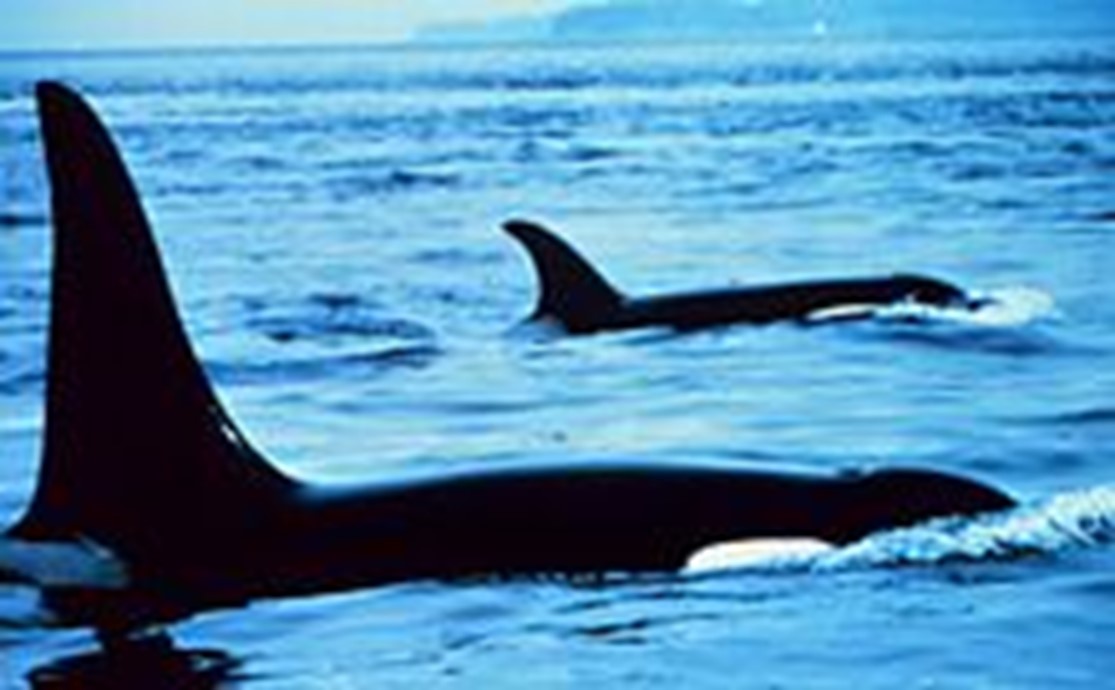
Figure 1: Killer whale sexual dimorphism (male in front and female in the background) (picture from national oceanic and atmospheric administration, www.noaa.gov)
Male killer whales measure between 6 and 9.5 meters and weigh between 3.6 and 9 tons; females are smaller, measuring between 5.2 and 7.3 meters for a mass of between 1.3 and 3.6 tons.
Orcas become adults in about fifteen years. From this age onwards, female individuals have fertile periods spaced three to sixteen months apart. The gestation period varies from fifteen to eighteen months. Mothers give birth to a single calf approximately once every five years. Newborns are breastfed for two years but begin to feed themselves at twelve months of age. Females reproduce until they are forty years old, raising an average of five offspring.
According to a study financed by SeaWorld, captive orcas have an average life expectancy of 41.6 years (both sexes combined) compared to the 29 years for populations of free killer whales.
Killer whales live, move and hunt in groups of 3 to 40 individuals in most oceans (called pods). The range of hunting techniques developed by killer whales is vast, depending on both the prey and the environment. For example, in the southern hemisphere, pinnipeds are sometimes hunted by deliberately stranding them on the beach. Killer whales use echolocation, a natural sonar system, for social interactions and hunting. Hunts can take place in the open sea or near the coast, in which case the prey is driven ashore until it can no longer escape its predators. When the pray is a large cetacean, all members of the group participate in the hunting, some holding the animal by the tail while others strike it from all sides.
Human-orcas interaction
Usually, in the wild, orcas are not afraid of boats and often approach them peacefully, notably orca’s sightseeing tours for tourist are available all over the world. Only few wild killer whale attacks on humans have been historically recorded and even less were the reported boat attacks: In an expedition to Antarctica at the beginning of the 20th century, the Terra Nova expedition, the photographer Herbert Ponting, approached a group of orcas and returned to the ship after feeling the ice blocks move under the pressure of the whales’ blows, which presumably wanted to knock him into the water. However, scientists have questioned the anthropophagic motivation of the animals, as the man, wrapped in fur, could have been mistaken for a penguin.
On 9 September 1972, a Californian surfer, Hans Kretschmer, testified that he was bitten by a killer whale at Point Sur. He received one hundred stitches. And in the same year a boat was sunk by a group of orcas next to the Galapagos islands. Same happened 1976 in Brazil.
In 2011, during the filming of the third episode of a BBC documentary Frozen Planet, a pod of orcas was filmed trying to overturn the film crew’s zodiac by forming waves. The crew had earlier filmed the same group of orcas hunting seals in the same way.
The new behavior
But from 2020 on the situation drastically changed. More and more attacks on boats started to happen. The interactions between boats (mostly medium sized sailing boats) and orcas in the past two years were 239 (see picture below), all of them in the region of the Strait of Gibraltar and heading West and North around the Iberian Peninsula.
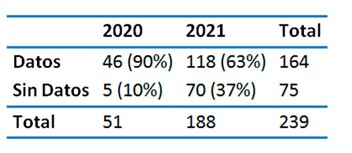
Figure 2: Numbers from the recorded interactions between orcas and boats in the past two years (the tendency for 2022 is increasing), from Orcaiberica.org. Datos= with information about boat and damage, sin datos= without any information.
No one really knows why this new pattern of behavior in this specific killer whale’s population is appeared.
Especially the sailor’s community is getting more and more anxious about this new and completely unpredictable issue. Out in the open sea there are already a lot of tricky situations to cope with and an additional “Russian roulette” like orca encounter is for most of them not at all necessary. On the other side orcas are protected animals and usually, no one is willing to harm them. But if the orca’s behavior will endanger more and more sailing boats as well as their crew’s safety, orcas’ population may soon also be under higher risk.
No one is really well informed, and the majority of people does not know what to do in such a situation. The fact that the change in killer whale behavior occurred at the same time as the worldwide Covid-19 pandemic is only a correlation, but many theories were developed to try to understand the reason of this new and quite problematic behavior.
Until now only two sources deliver scientifically proven data about this topic and try to explain and help. On one side the CA cruising association in collaboration with the GTOA (Group of work of the Atlantic orcas) is recording all the attacks and interactions and delivers up to date rules to follow if such a meeting with an orcas may happen to you. On the other side, Orcaiberica (research group located in Madeira) is studying the problematic pods and tracking them.
Of course, beside the scientific work quite many experience-related tips and tricks pop up from social media and spread quite fast. For example, going back to the previously mentioned possible correlation between the worldwide pandemic and the new orca behavior; some sailors think that the absence of (fishing) boats during these years has made the killer whales more sensitive to the presence of boats (maybe because they had moved to zones that they previously avoided due to the human presence), leading them to attack the boats that return in their new acquired territories. Still, this would not explain why, only a specific population of orcas is behaving differently (the recorded attacks are all in the same region extending from Gibraltar to Galicia).
Let us briefly focus on this specific population, the orca iberica (ca. 50 individuals). They are nomadic orcas that follow the tuna population (their mayor food source), which in turn also migrate from the south to the north to seek food (see picture below). This means that orcas in this area tend to migrate to the north following their prey. Given that killer whales can swim up to a velocity of 50 km/h (and the tuna even faster), and that the distance between Gibraltar and Galicia is approximately 1500 km, it is theoretically possible for them to span this “hot area” in 30 hours. Consequently, any recorded attack could theoretically come from the same pod of orcas, letting free space for unexpected localization of aggressive pods and uncertainty. It is very difficult to prevent the encounters, just by avoiding navigating in the same area as the killer whales, just because we do not always know where they are and they move fast. Videos and pictures taken during the encounters (analyzed by the Madeira research group) exclude that only one individuum is behaving “abnormally” and attacking all the boats. Shape and size of the with patch on the animals back help the researchers identifying them, if video and picture material is available. Of course, in these threatening situations not all are prone and ready to film and take picture, making impossible to constantly identify the animals.
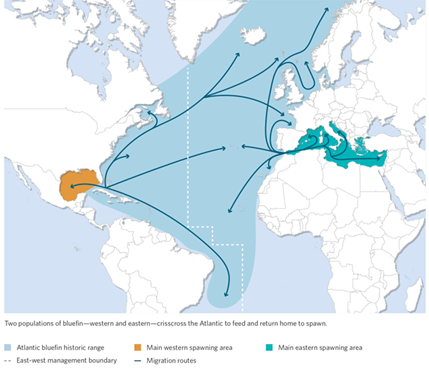
Figure 3: Tuna population migration routes. The one relevant here is depicted on the right, where the tunas move from the Gibraltar strict to the north. https://www.pewtrusts.org/en/research-and-analysis/issue-briefs/2017/10/the-story-of-atlantic-bluefin
A bit of statistics
Overall, the statistics of the attacks are quite bad. But efforts have been made. It is known (from the data depository in the CA cruising association) that in the second half of August 9 encounters happened in the north of Spain, during this period in the same area, an average of 32 boats per day were out sailing (data from mobile app Marine Traffic, only boats with vhf radio, mean of 0.5 encounter per day, less than 2% chance for a sailing boat in the area to encounter an orca).
The collected data is quite robust on constancy of boats travelling in this area per day (SD= 11.22), whereas attacks distribution varies. Boats density seems also not to be an indicator of enhanced orca attacks. Hot spots of consecutive attacks could thereafter be explained by aggressive individuals located in this area attacking more boats on consecutive days.
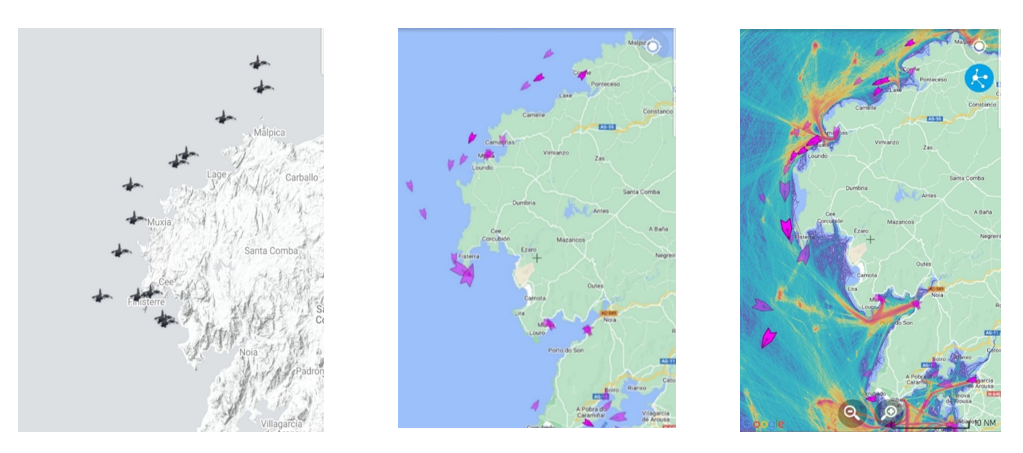
Figure 4: From left to right, killer whale encounters in August, map of the boats navigating in the area (only the ones with VHF (very high frequency radio), example from the 27.8.2022 at 4pm), boat density in the same area.
The typical orca attack does usually follow quite a structured pattern. The animals show a really targeted behavior and after some minutes of swimming along with the boat, start to swim underwater and bump against the hull of the boat, bite the rudder damaging it to the point that the boat can no longer navigate and have to be transported in a port for reparations. It has been stated that up to 15% of yachts experiencing and reporting this behavior have had to be towed to port (Orcaiberica.org).
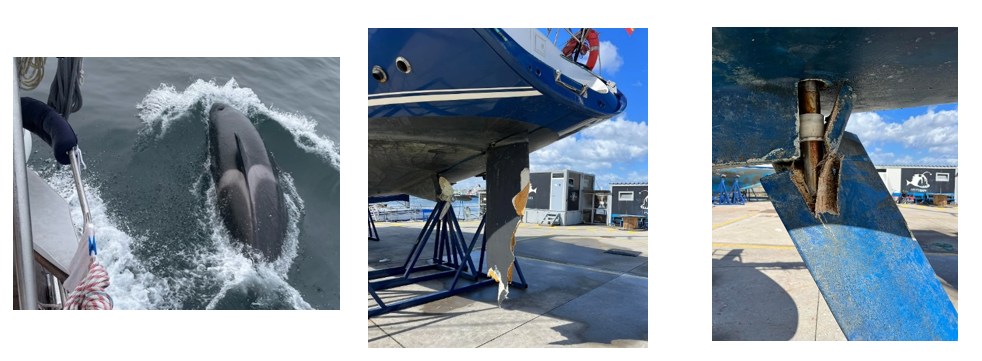
Figure 5: From left to right, an orca swimming along a boat and the damaged rudder after an attack (Facebook, Orca Attacks Reporting Group).
The local institutions provide some tips about what to do when an interaction happens and delivers maps with risk level depending on previous attacks and animals’ trajectories.
Do and don’t list
As already said killer whale are protected animals, meaning is not possible to hunt, harm or damage them in any way. Underwater explosions, shots and loud noises are thereafter strictly forbidden. The best practice, at the moment, suggests stopping the boat immediately, furl sails, let the wheel/tiller run free and remove autopilot. Furthermore, contact the authorities on VHF 16 or by phone on 112; keep a low profile on deck to minimize the interest to the orcas and take photograph or video evidence. Make a note of location co-ordinates and timing of the interaction along with any other relevant details including the behavior of the orcas for future reporting. After the interaction ceases wait for several minutes to allow the orcas to move away from the area before any interest is re-gained.
Some reports on social media indicate that motoring in reverse has deterred interactions but these results are not yet proven. Skippers must bear in mind that deliberately aiming a propeller at an orca is illegal. They must also know that reversing in certain sea states can be dangerous and should assess conditions before using this measure.
Rationale of this maneuver seems to be that the water movements caused by reverse gearing disturb the orcas, which may swim away. Effectiveness of this procedure is yet not statistically established but it is of no harm for the animals and thereafter supported by almost everyone.
Another interesting protective measure could be to use more resistant boats to protect the crews. Then perhaps people would no longer react in panic to such encounters, but experience them as unique encounters. Of course, costs of this measure are quite high and thereafter not widely applicable.
Extras, without any scientific fundament
Beside the recommendations, some sailors have tried others measures and have shared their experiences on the social medias. Pingers (see figure 6) are instrument emitting some noises at specific frequency (3-70 kHz), historically used by fishermen to keep dolphins away from the nets. As killer whales also use echolocalization it was assumed that this objects, launched into water upon encounter with orcas should keep them away. As is seems that sometimes they don’t even work with dolphins, the efficacy on orcas is quite debatable.
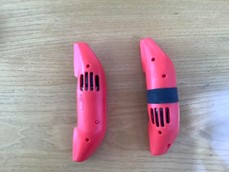
Figure 6: Pingers
To best cope with this disruptive behavior, the underlying cause should be discovered and from then solutions and actions plans could be of easier implementation. But, as no one really knows why these pods of killer whale behave differently, no one really have applicable solutions.
Only assumptions have been made: some think that the orcas started to experience the fishermen and thus larger boats as strong food competitors for tuna. As is true that intensive fishing of the last years could have partially depleted tuna stocks, increasing the competition for the food sources, it is also true that fishing has been going on in the region for centuries and the Gibraltar orcas have come to terms with the fishermen; some killer whale families, for example, have learned to pluck the catch directly from the hooks while hauling in the lines, potentially also profiting from the fisherman activities.
Researchers widely agree that the Gibraltar killer whales are under severe stress. The orcas are disturbed or injured by fishing boats, sometimes even losing their calves because they get caught in the nets. Irate fishermen also try to drive away the black-and-white sea hunters by throwing stones, sometimes even with electric shocks, which are actually used to stun the tuna on the hook (orcas may have associated these maltreatments to boats in general, developing the aggressive behavior against them).
The attacked boats have little in common. All colors, speeds and sizes (up to 15-16 meters) are occasionally attacked. Some think that orcas’ attacks boats because they think they are mammals to hunt, this would speak for some hull special design to avoid the attacks. If the antifouling of the boat is bright or colored, it may deter the animals to attack. Similarly, you could put lights underwater to deter the orcas. Others think that painting an eye on the bottom of the boat could scare the animals. But again, the resemblance of the boat to a large animal could also reinforce the attacks of the orcas if their motivation is hunting.
To prevent encounters, you can try to travel closer to the coast, but then you risk more problems with the rocks, and you may still encounter orcas there. It is also possible to travel with other boats, without any security that this will deter the orcas.
At the moment the topic is still very new and less scientific research is available but as the community is interested in solutions, also scientists and authorities are putting efforts in understanding this new pattern of behavior better. This is why I think was actually worth to put some effort to organize and summarize the information available in such a topic and with this post I hope to reach also people that have no clue about orcas (like me some weeks ago) and which may become interested and would like to follow up; maybe next year it will be your turn to join Gaia, trust me it is worth it!
References
Reisinger, Ryan R.; Keith, Mark; Andrews, Russel D.; de Bruyn, P. J. N. (December 2015). « Movement and diving of killer whales (Orcinus orca) at a Southern Ocean archipelago ». Journal of Experimental Marine Biology and Ecology. 473: 90–102.
« Orcinus orca (Linnaeus, 1758) ». Integrated Taxonomic Information System.
« Facts about orcas (killer whales) ». Whales.org. Whale & Dolphin Conservation USA. 2022.
Kremers, D.; Lemasson, A.; Almunia, J.; Wanker, R. (2012). « Vocal sharing and individual acoustic distinctiveness within a group of captive orcas (Orcinus orca) ». Journal of Comparative Psychology.
« SeaWorld to End Controversial Orca Shows and Breeding ». National Geographic News. March 17, 2016. Archived from the original on April 20, 2016.
« Boy survives bump from killer whale ». The Seattle Times. The Associated Press. August 18, 2005. Archived from the original on April 2, 2011. Retrieved January 3, 2010.
Cherry-Garrard, Apsley (2004). The Worst Journey in the World: Antarctic 1910–1913. Globe Pequot. p. 92. ISBN 978-1-59228-212-8.
« Keep Whales Wild ». Keep Whales Wild. January 14, 2011. Archived from the original on December 16, 2010.
« Orca shares the waves with local surfer ». 3 News. September 12, 2008. Archived from the original on July 24, 2011.
The Pew Charitable Trusts, “Case Studies of Harvest Strategies in Global Fisheries: Charting the Course of Future Tuna Management” (2016), http://www.pewtrusts.org/en/research-and-analysis/issue-briefs/2016/09/case-studies-of-harvest-strategies-in-globalfisheries.
Orca Attack reporting, Facebook group.
MarineTraffic app.
https://www.theca.org.uk/orcas (6.9.2022)
https://www.orcaiberica.org/resume (6.9.2022)



